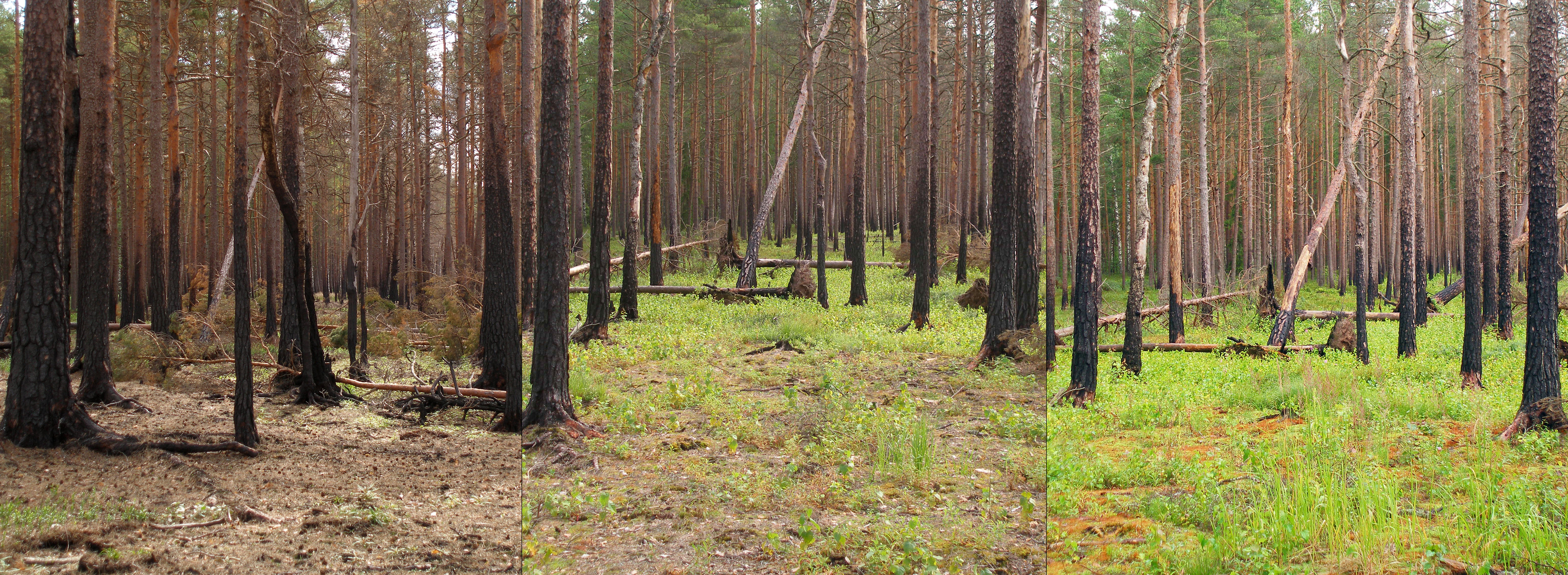Complex early seral forest on:
[Wikipedia]
[Google]
[Amazon]
Complex early 

seral
A seral community is an intermediate stage found in ecological succession in an ecosystem advancing towards its climax community. In many cases more than one seral stage evolves until climax conditions are attained. A prisere is a collection of se ...
forests, or snag forests, are ecosystems that occupy potentially forested sites after a stand-replacement disturbance and before re-establishment of a closed forest canopy. They are generated by natural disturbances such as wildfire
A wildfire, forest fire, bushfire, wildland fire or rural fire is an unplanned, uncontrolled and unpredictable fire in an area of combustible vegetation. Depending on the type of vegetation present, a wildfire may be more specifically identi ...
or insect outbreaks that reset ecological succession processes and follow a pathway that is influenced by biological legacies (e.g., large live trees and snags
In forest ecology, a snag refers to a standing, dead or dying tree, often missing a top or most of the smaller branches. In freshwater ecology it refers to trees, branches, and other pieces of naturally occurring wood found sunken in rivers and ...
, downed logs, seed banks, resprout tissue, fungi, and other live and dead biomass) that were not removed during the initial disturbance. Complex early seral forests develop with rich biodiversity because the remaining biomass provides resources to many life forms and because of habitat heterogeneity provided by the disturbances that generated them. In this and other ways, complex early seral forests differ from simplified early successional forests created by logging. Complex early seral forest habitat is threatened from fire suppression, thinning, and post-fire or post-insect outbreak logging.

Ecology
Complex early seral forests are structurally more complex, contain more large trees and snags, and have more diverse understories, more functional ecosystem processes, and more diverse gene pools than areas of timber harvest. These characteristics provide greater resilience in the face of climate change than that provided by the simplified early seral forests produced by logging. Complex early seral forest attributes promote a high level of species richness, particularly bird communities that utilize these forests extensively. The residual biomass of snags reduces disturbance stress and provides for the rapid proliferation of new life For example, seed banks and live vegetation tissue gives rise to denseforb
A forb or phorb is an herbaceous flowering plant that is not a graminoid (grass, sedge, or rush). The term is used in biology and in vegetation ecology, especially in relation to grasslands and understory. Typically these are dicots without woo ...
cover, abundant grasses, and shrubs – especially nitrogen fixers (e.g., Ceanothus spp.) and ectomycorrhizal associates (e.g., Manzanita
Manzanita is a common name for many species of the genus ''Arctostaphylos''. They are evergreen shrubs or small trees present in the chaparral biome of western North America, where they occur from Southern British Columbia and Washington to Or ...
spp.) that facilitate conifer growth. Closed cone conifers like giant sequoia
''Sequoiadendron giganteum'' (giant sequoia; also known as giant redwood, Sierra redwood, Sierran redwood, California big tree, Wellingtonia or simply big treea nickname also used by John Muir) is the sole living species in the genus ''Sequoiade ...
also do well in these forests. Other plants that can abundantly colonize burns, such as conifers and fireweed
''Chamaenerion angustifolium'' is a perennial herbaceous flowering plant in the willowherb family Onagraceae. It is known in North America as fireweed, in some parts of Canada as great willowherb, in Britain and Ireland as rosebay willowherb. ...
, arrive by wind or animal dispersed seed. Plant species richness of snag forests can be much higher than in unburned forests.
Bird and small mammal communities that utilize complex early seral forests forage on the abundant insects and increased abundance of seeds in the post-fire flora. These species, in turn, support an increase in raptors. Bird species such as the Black-backed Woodpecker, Olive-sided Flycatcher (Contopus cooperi), Mountain Bluebird (Sialia currucoides), Chipping Sparrow (Spizella passerina), and Mountain Quail (Oreortyx pictus) achieve highest abundances in complex early seral forests. Bats (Myotis, Idionycteris, Lasionycteris, and Eptesicus) also use complex early seral forests because of greater insect prey as well as suitable roosts. Stand-replacing fires stimulate an increased flow of aquatic prey to terrestrial habitats, driving increases in riparian consumers. The trees killed by fire are beneficial to the ecological integrity of stream communities because they are a main source of large woody debris inputs. There is also reproduction by some forest fungi species that are restricted to burns (e.g., morels, ''Morchella'' spp.) and the dead wood provides substrate for fungal growth that supports many arthropod species, including unique fire-following native beetles. Beetles, in general, colonize fire-killed trees in complex early seral forests and their abundant larvae support species like Black-backed Woodpeckers Forest and Spotted Owl management documents often state that severe wildfire
A wildfire, forest fire, bushfire, wildland fire or rural fire is an unplanned, uncontrolled and unpredictable fire in an area of combustible vegetation. Depending on the type of vegetation present, a wildfire may be more specifically identi ...
is a cause of recent declines in populations of spotted owls poses a primary threat to Spotted Owl population viability, but a systematic review and meta-analysis found fires created more benefits than costs for spotted owls.

References
External links
{{Vegetation Ecological succession Wildfire ecology